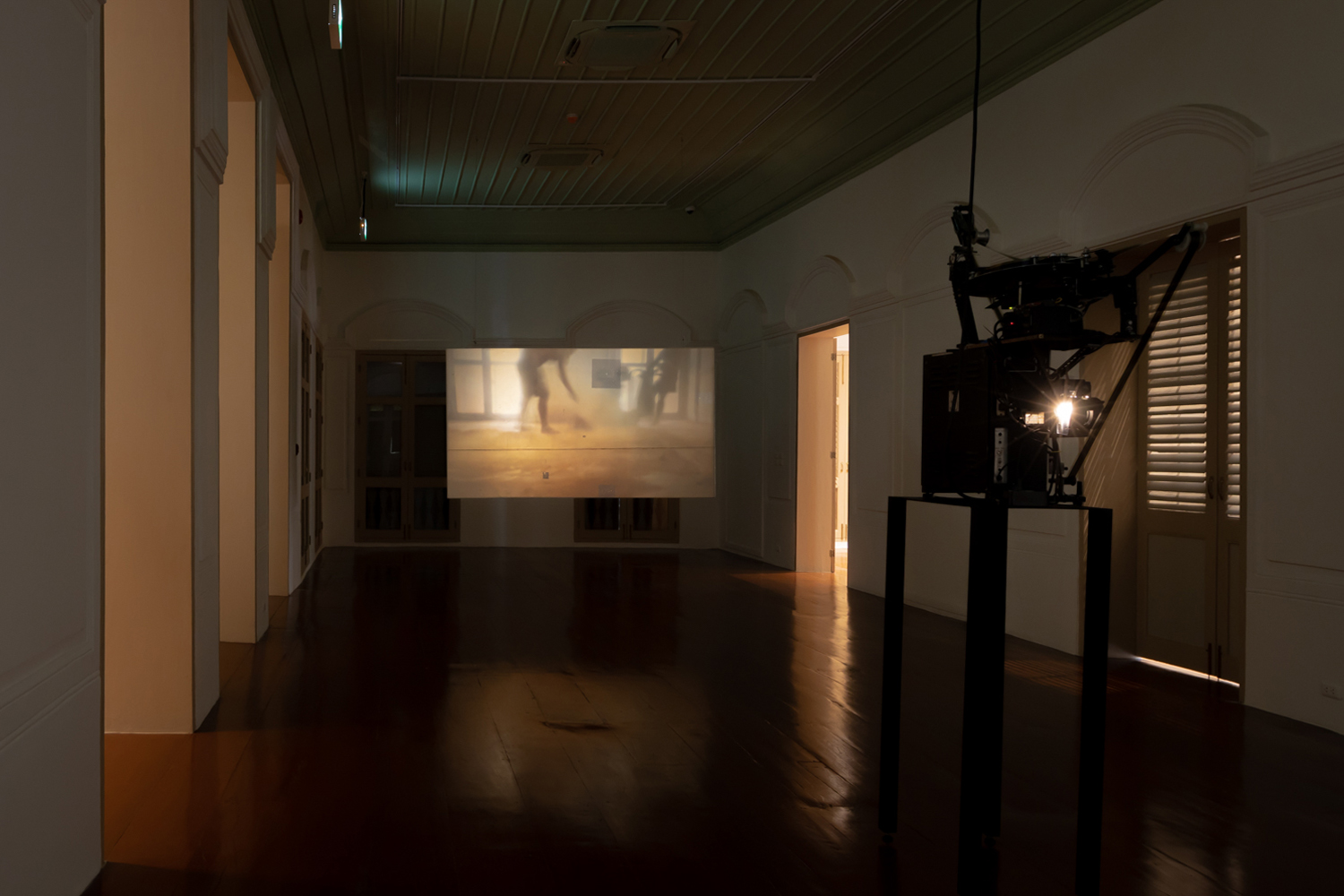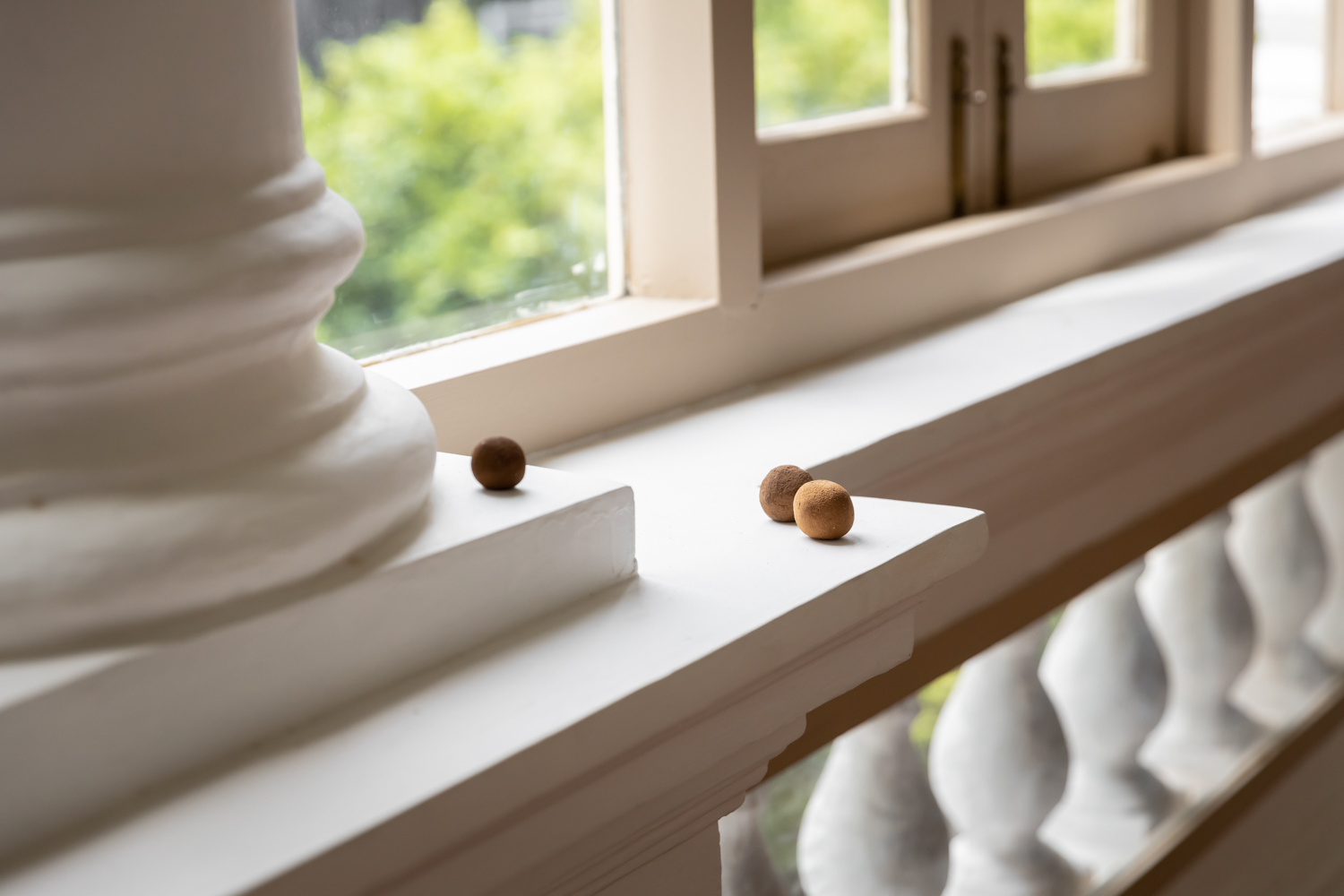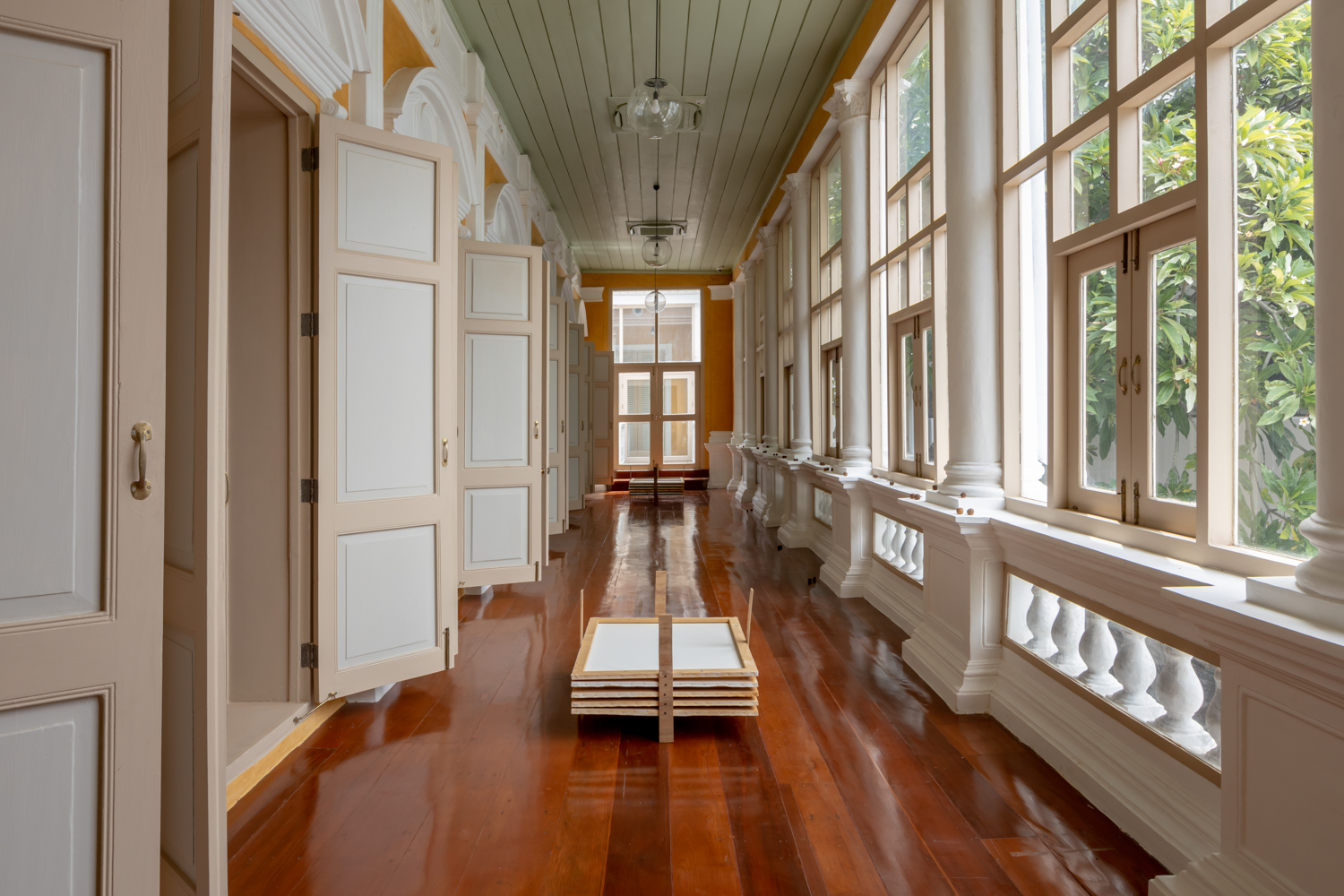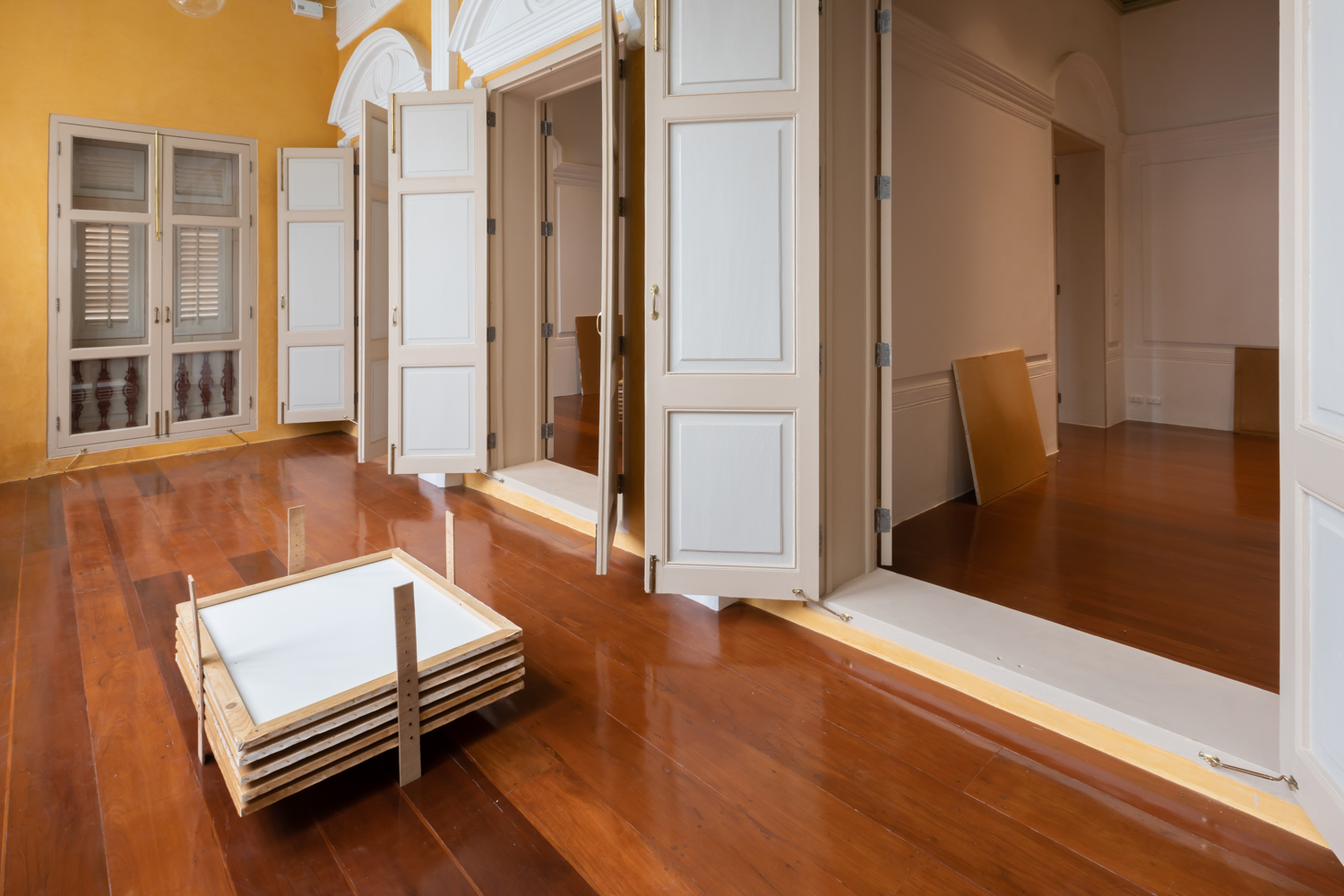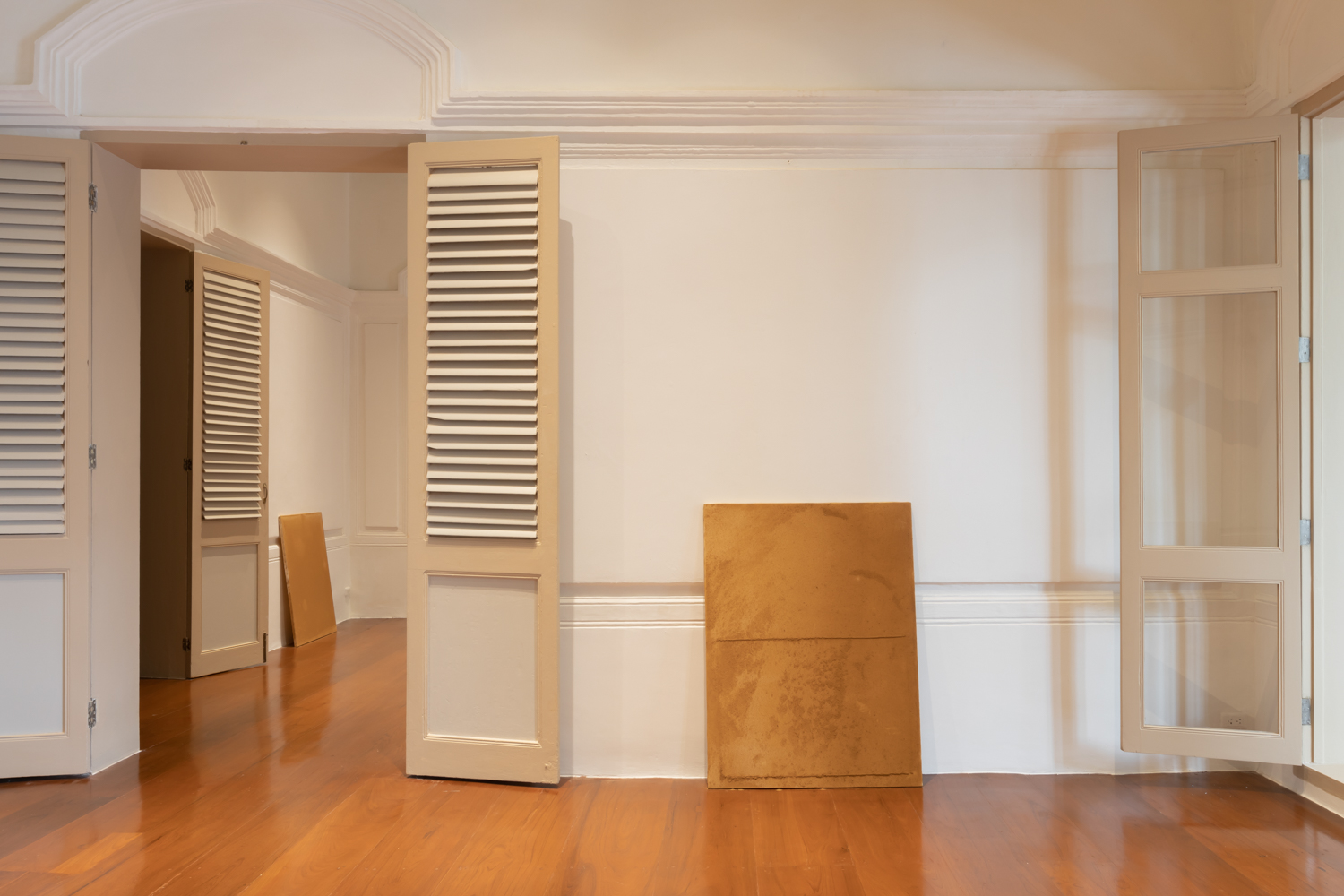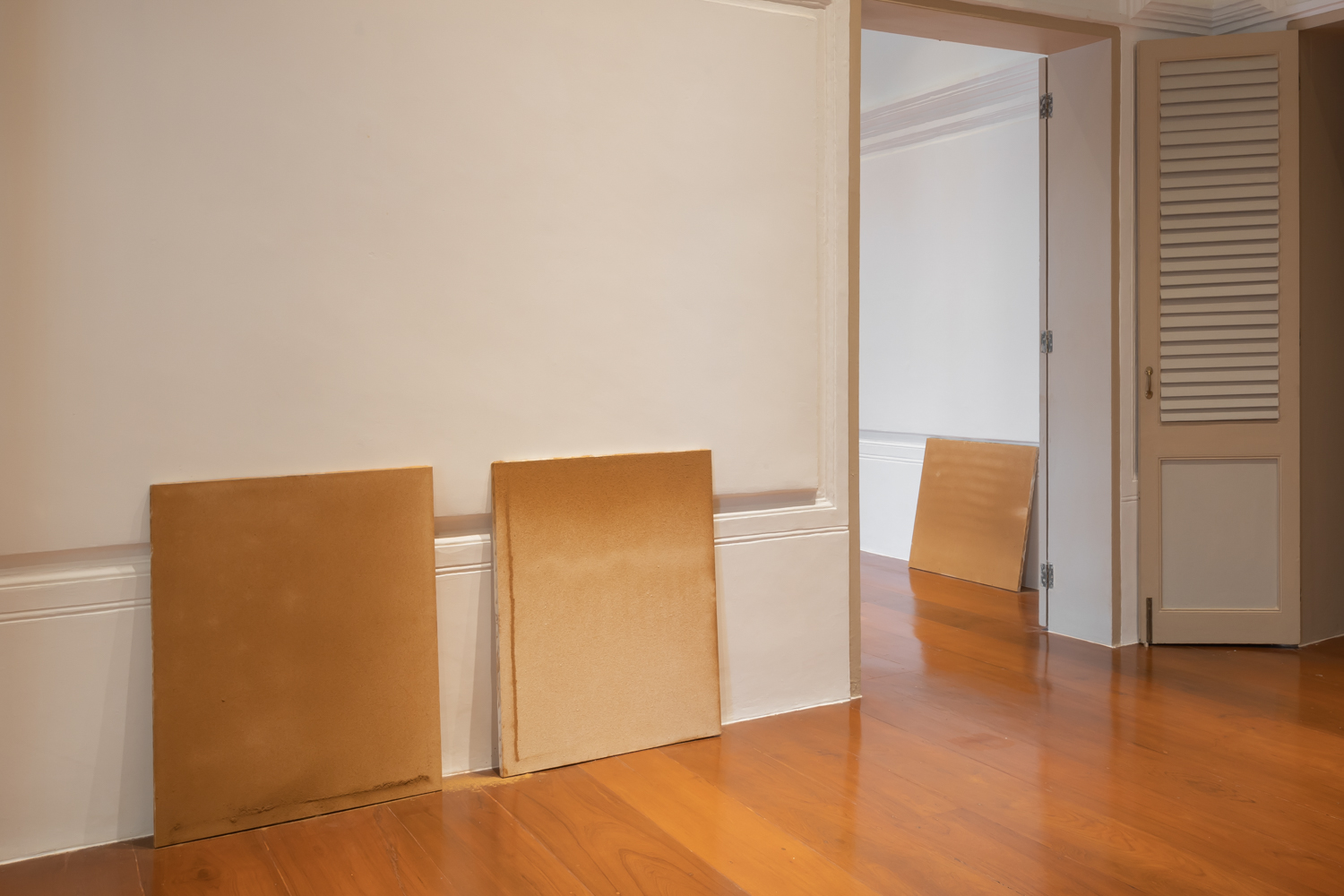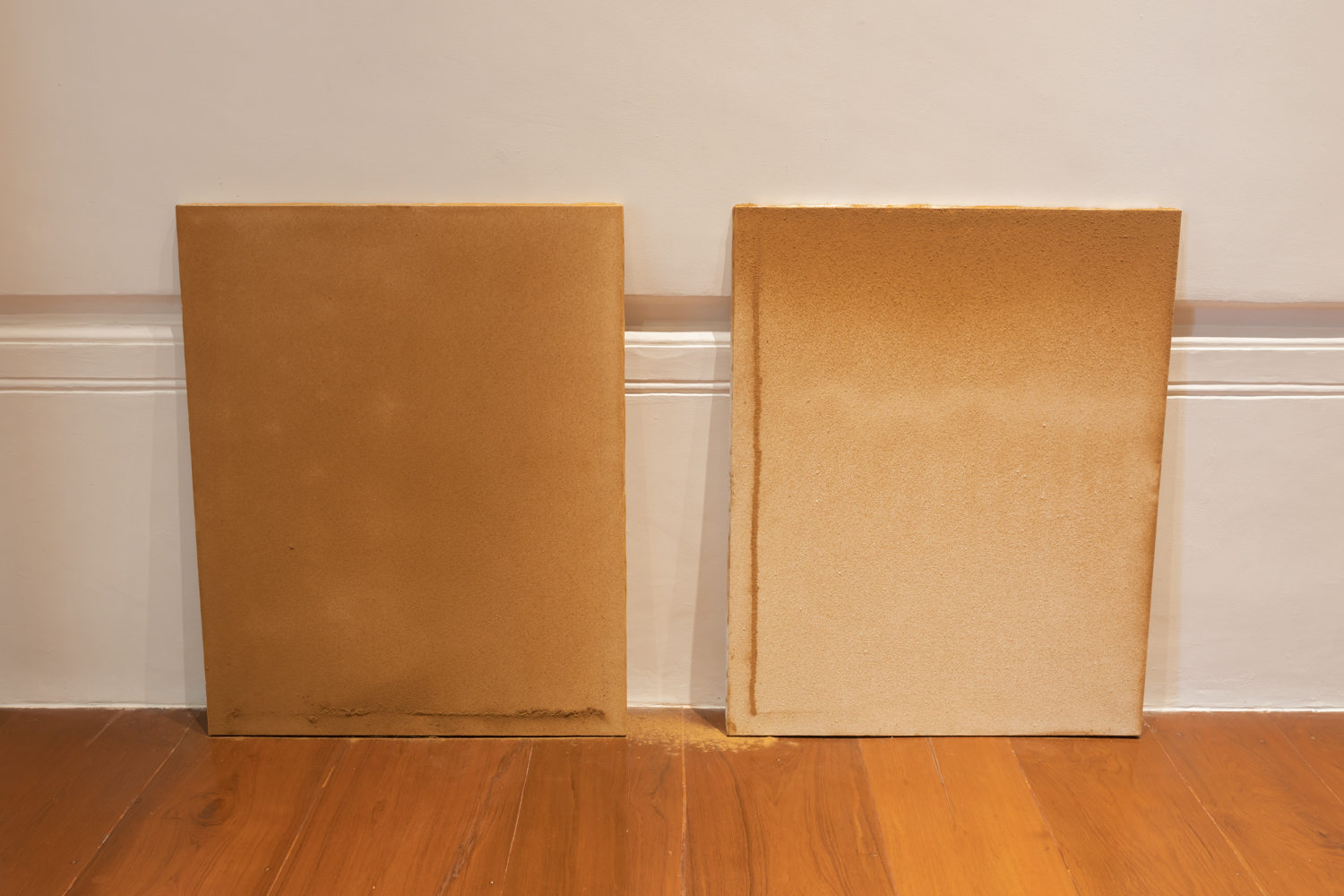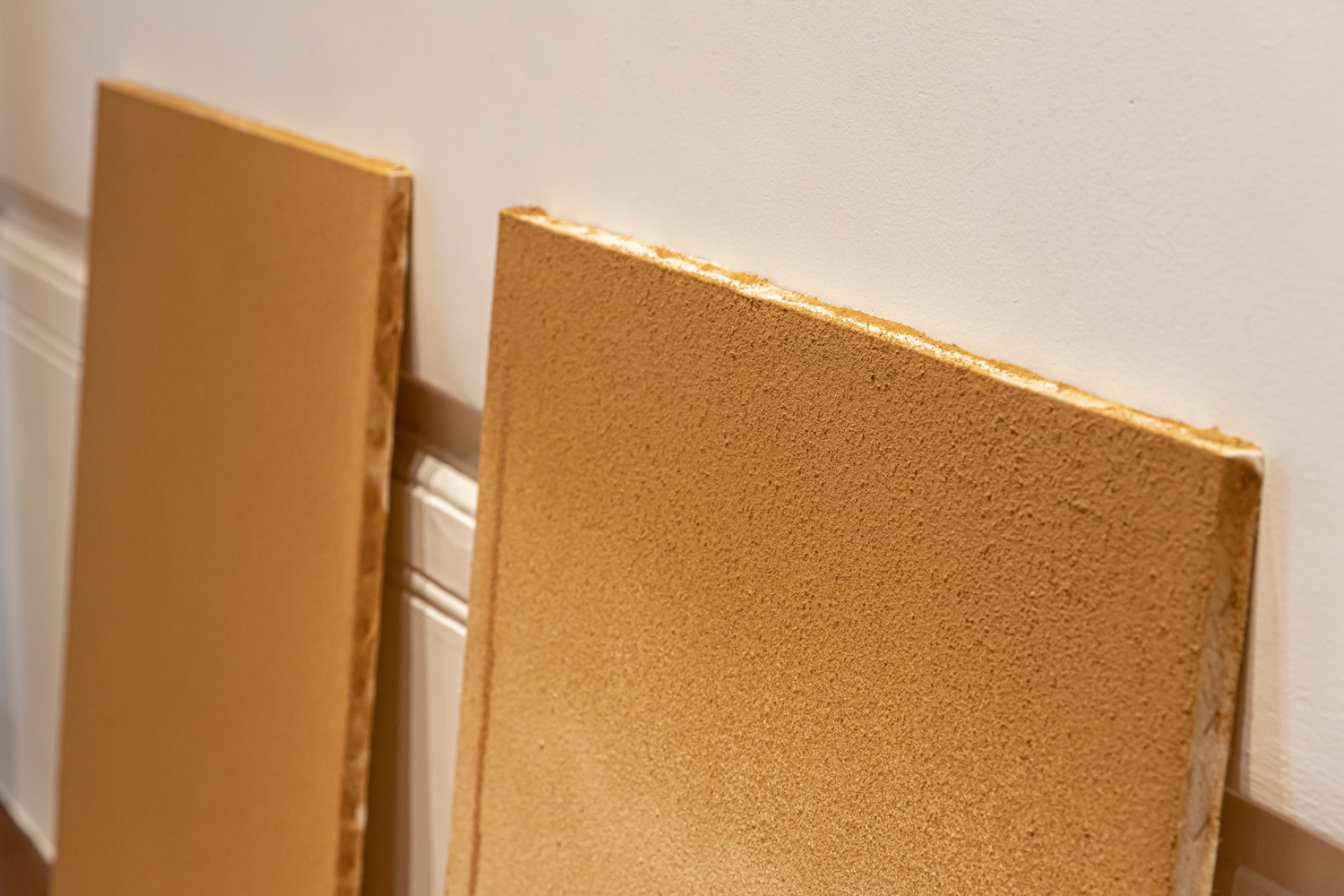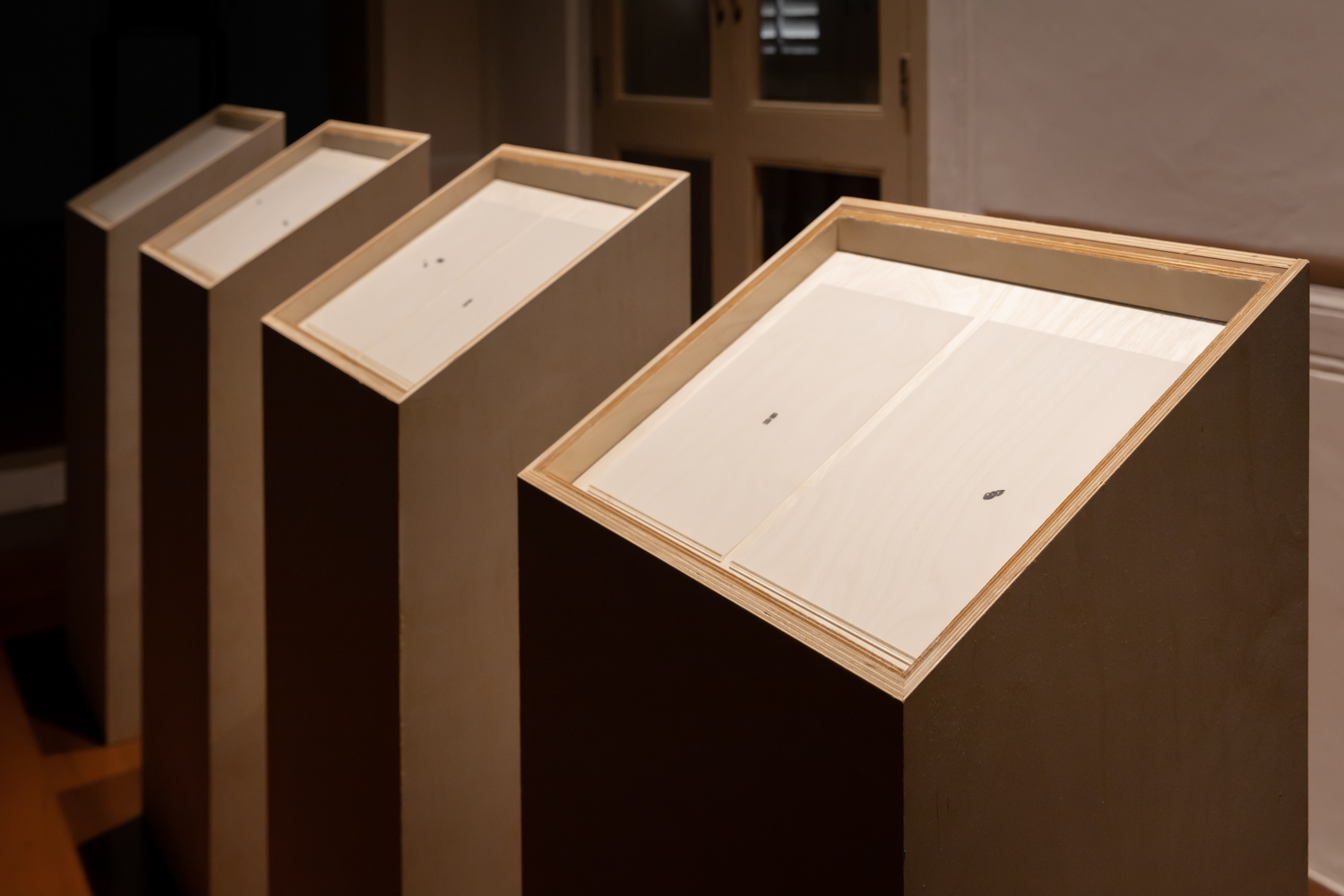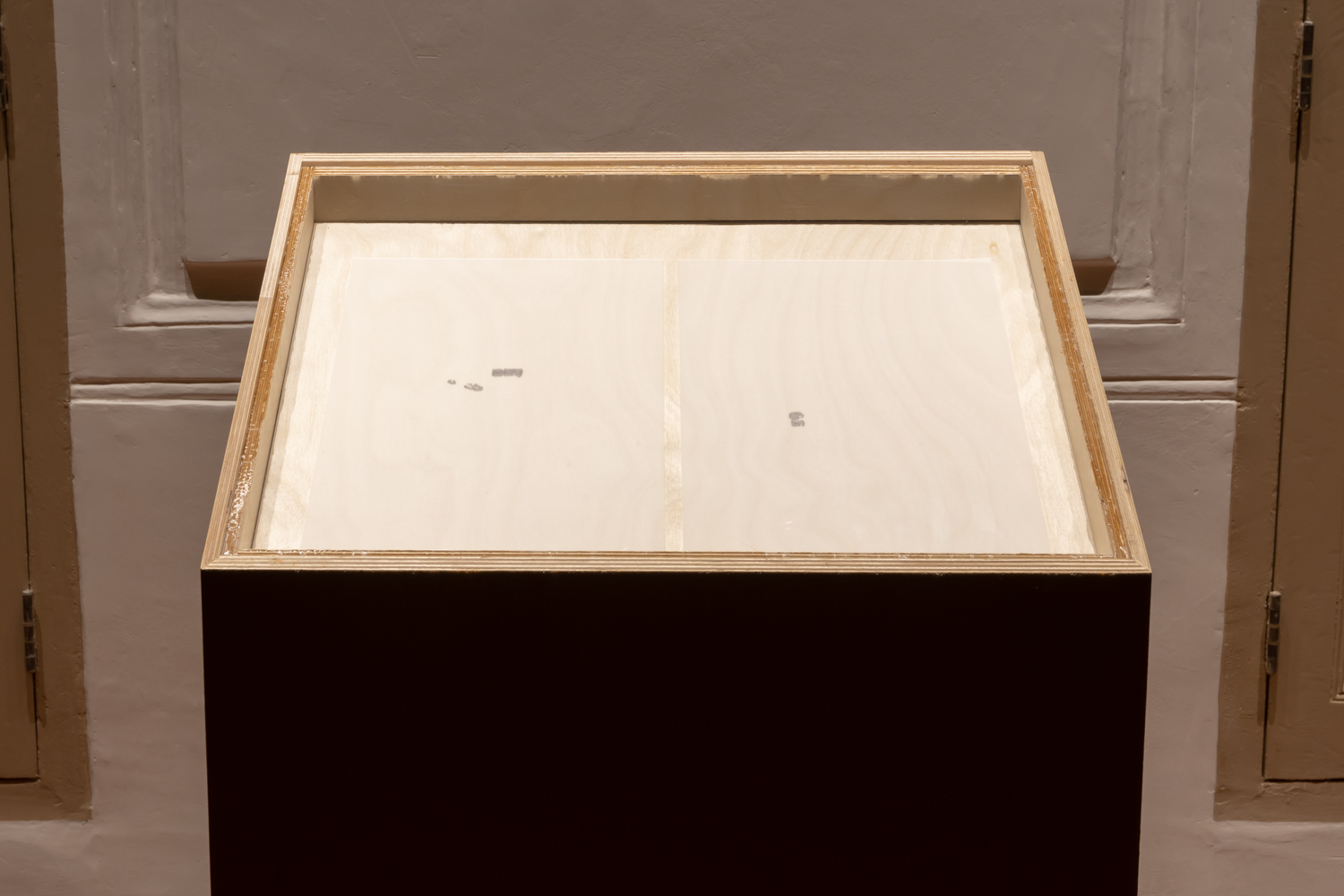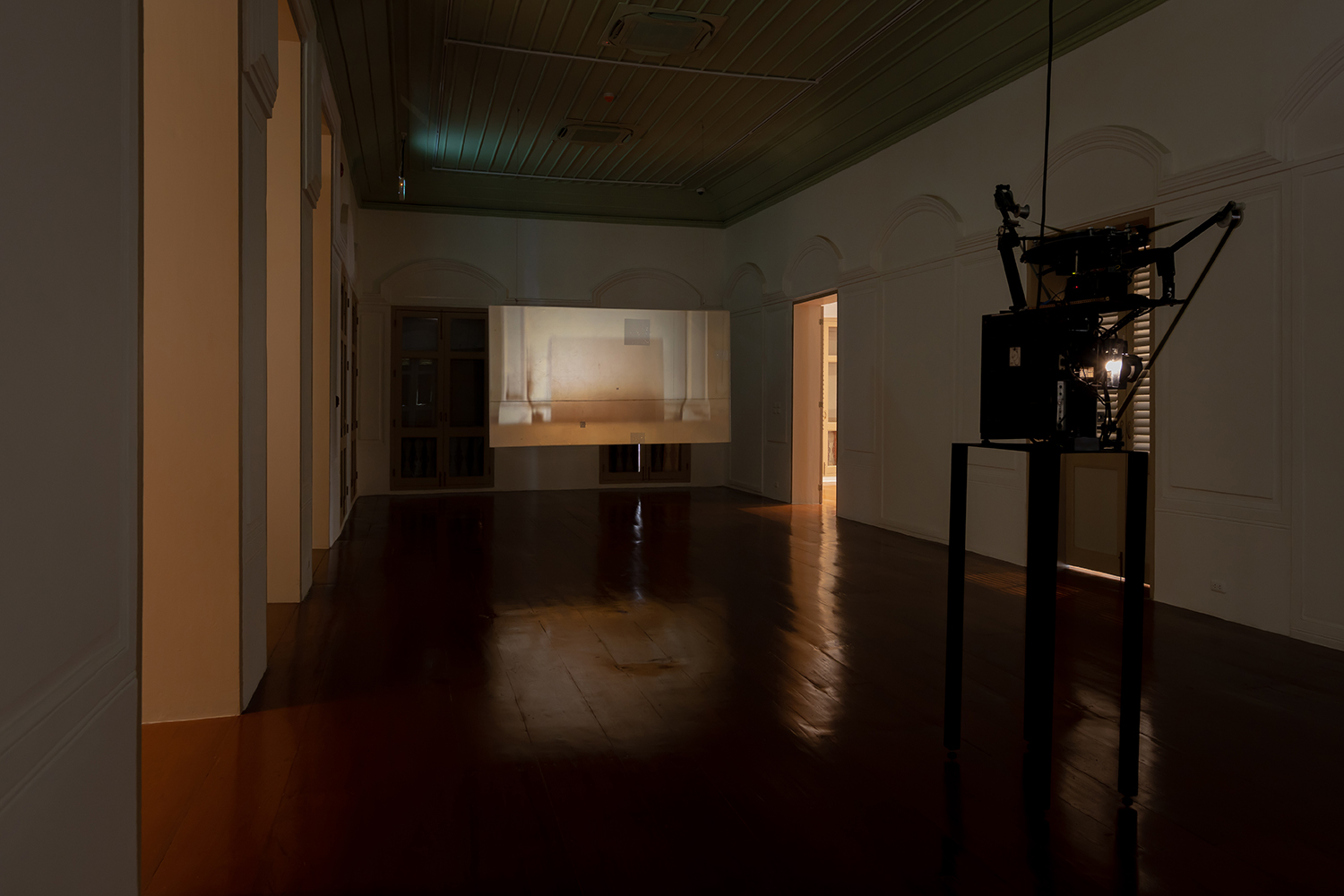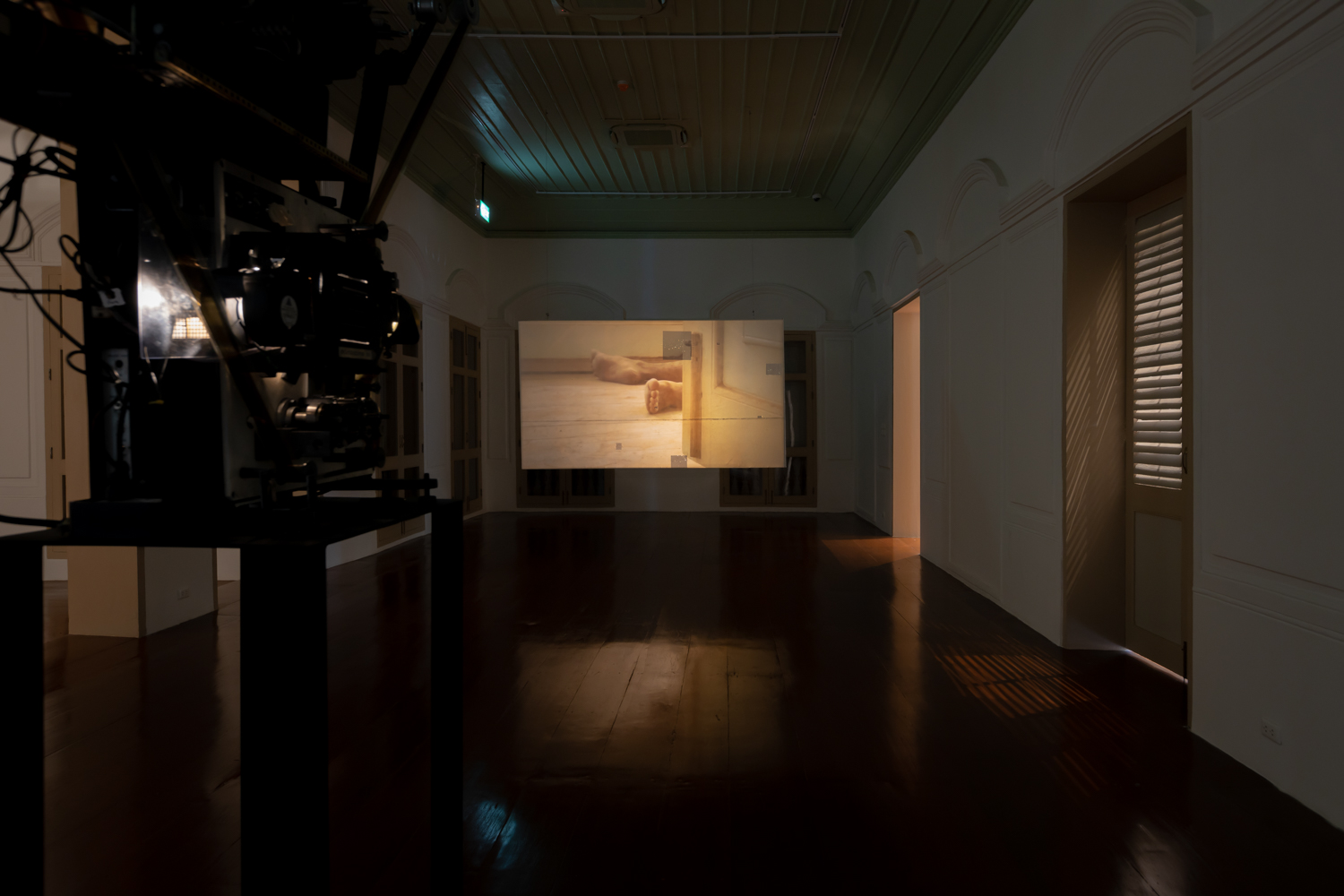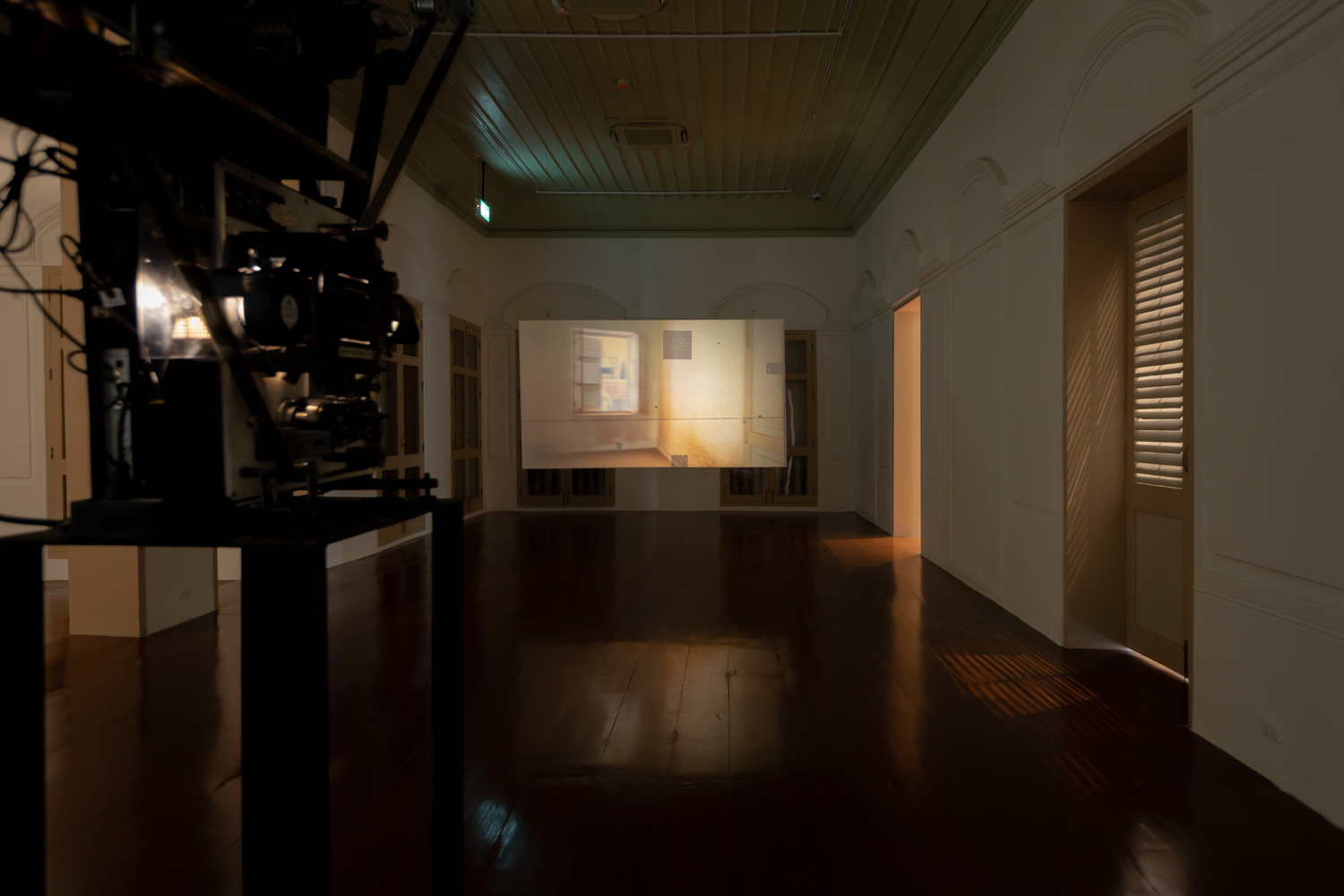WHILE THE ART CENTRE AT SILPAKORN UNIVERSITY WANG THAPRA CAMPUS UNDERWENT A REFURBISHMENT, PRATCHAYA PHINTHONG INCORPORATED HIMSELF WITH THE TEAM OF ARTISANS AND BROUGHT A FRAGILE MOMENT OF THE GALLERY INTO THE ARTWORKS
TEXT: NAPAT CHARITBUTRA
PHOTO: KETSIREE WONGWAN
(For Thai, press here)

After a five-year closure for renovations, Silpakorn University (Wang Thapra Campus) finally and officially reopens. Like other buildings on the campus’ ground, the Art Centre at Wang Thapra campus underwent its own refurbishment but the only distinction is this revamp had artist Pratchaya Phinthong contributing as a part of the assigned team of artisans.

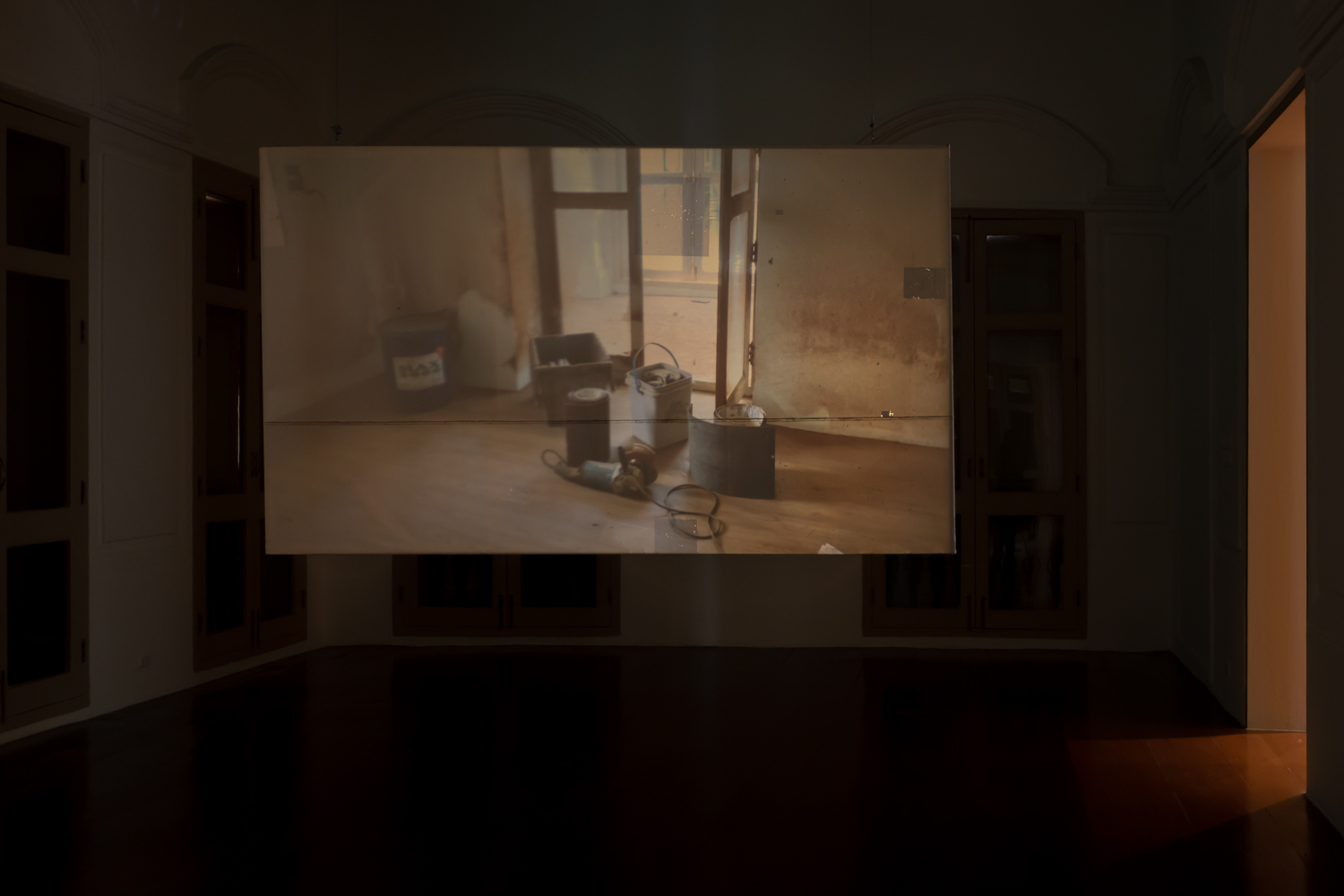

Beginning with debris and sawdust scattered from the polishing of teak wood, Extended Release, 2020, is a video installation piece (it’s a part of the exhibition with the same name) where Pratchaya used his smartphone to record the tiny particles scraped off the surface they were once part of, floating in the air. The footage was converted into 35 mm film and is now being screened in the space on the second floor of the main art gallery since all the renovations are now completed.
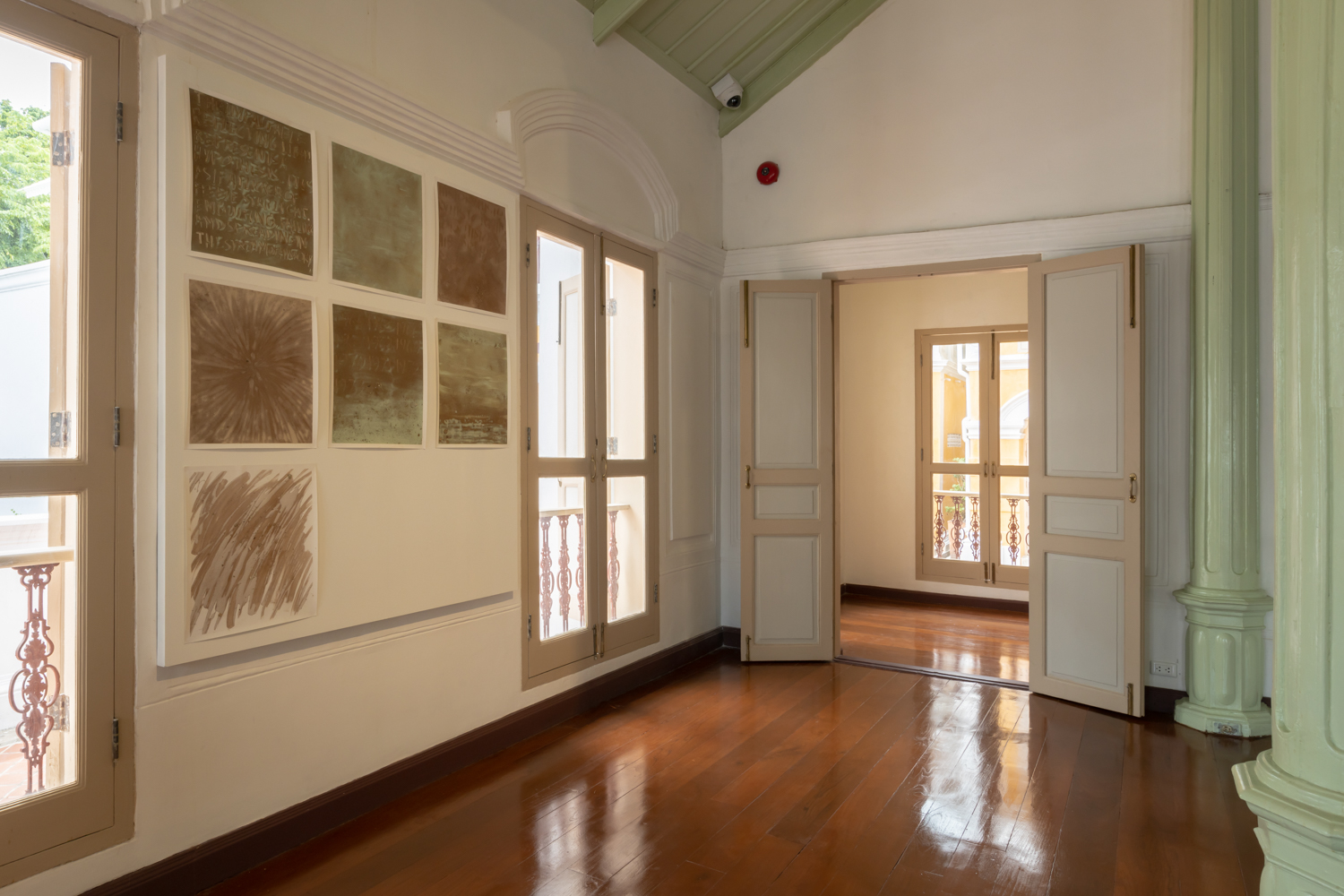

The throne room is the space that holds the works that Pratchaya co-created with Kritsada Duchsadeevanich, the curator. The mirror door installed at the main building’s ground floor is equivalent in size as the other doors but is molded using aluminum from the bombs left in Laos by the U.S. Armed Forces during the Cold War. Titled ‘You are part of everything you are not, 2021’, the work is situated not too far from and in a dialogue with ‘The Sacred Buddha Images of Thailand’ Book whose installation shows the 70th page that tells the story of the making of Phra Glak Fin (Phra Buddha Setthamunee), the sacred Buddha sculpture made from ancient opium container during the reign of King Rama 3. Reaching the second floor, one will come across Internal Rhyme, the work the artist created back in 2015. Exhibited further into the space is the addition of Extended Release where 31 pieces of canvas with their surfaces coated with dust are installed. Some of the framed canvases lean against the walls while some are stacked in piles with their fronts facing down on the floor of the exhibition room. Roaming the space, one can see a bunch of ‘Seed Bombs’, which are essentially masses of dust rolled into a bunch of balls, each stuffed with herbal seeds inside.
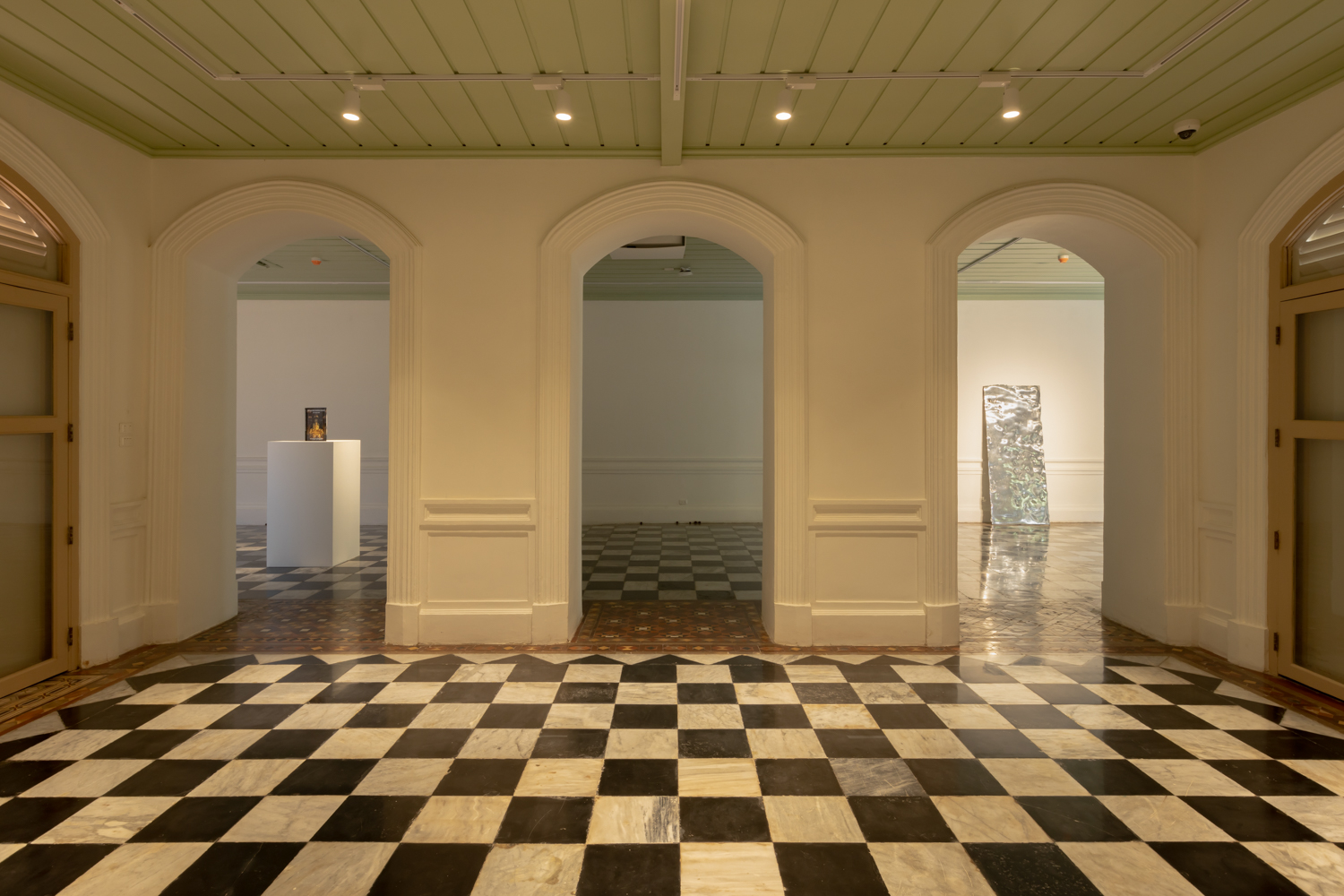

Pratchaya travels back in time, converting MPEG4 video files into 35 mm film, revisiting a time of crisis in this region (which has seen constant crises throughout its history) when Siam was at war with Laos during the Cold War (the period between the reign of King Rama 2 and King Rama 3). The film projects an image of the terrace of Pridi Banomyong’s house in France. I, then, realized that to read into Extended Release, I might have to look beyond the boundaries of time.


The positions and formats of the way the 31 canvases are displayed imply back-and-forth rotation and the non-linear nature of time in this exhibition, particularly the non-hanging installation and the way it conveys how the works are trapped between time– an ambiguous stage between being exhibited and stored. The layering of the stacked pile of canvases bears some sort of connection with geographical layers, especially in the context of archaeological excavation and the methodology and thought process of philosophical archeology, which is based on the foundation that no discourse is originated from one origin but rather a combination of factors, at a certain point in time, before it is washed away in the ruins of what would later be a replaced discourse. This means that the root of whatever is growing on the surface may not have any relation to the seed buried far underneath. What’s visible on the exterior, however, can be a result of elements that may be related or conflicted, clashing and colliding over a period of time before disappearing without any trace.

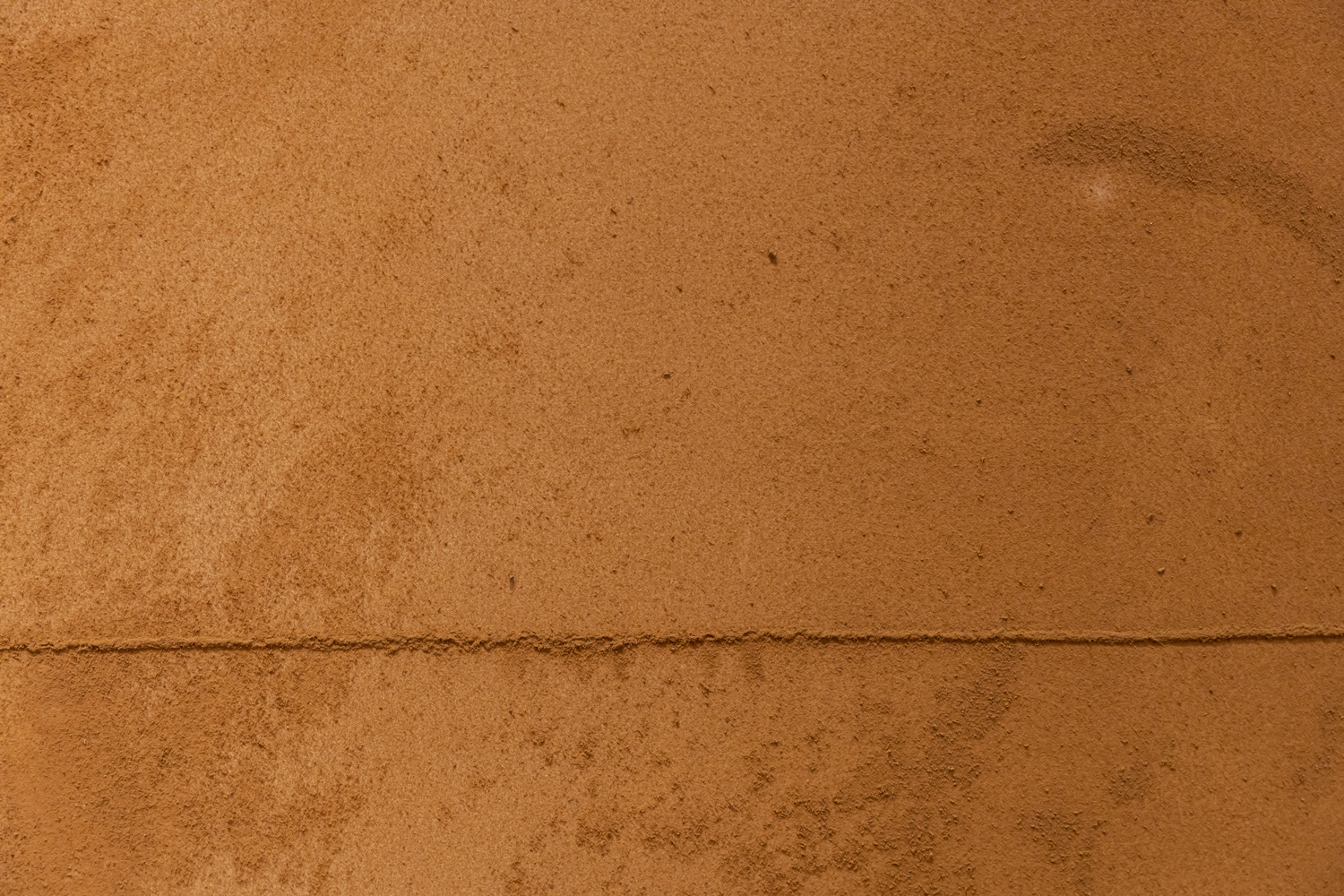
Such method contradicts with the process of historialization, which focuses on the unification of the past and present into one linear narrative. This is perhaps the issue of how art has been viewed and written by philosophy. The way scattered information is handled isn’t merely about eliminating the parts that don’t belong and selectively putting together what one sees fit to create a narrative. It should be about finding the keywords, keeping them in mind before putting fragmented pieces together as we search for other stories hidden in the past.
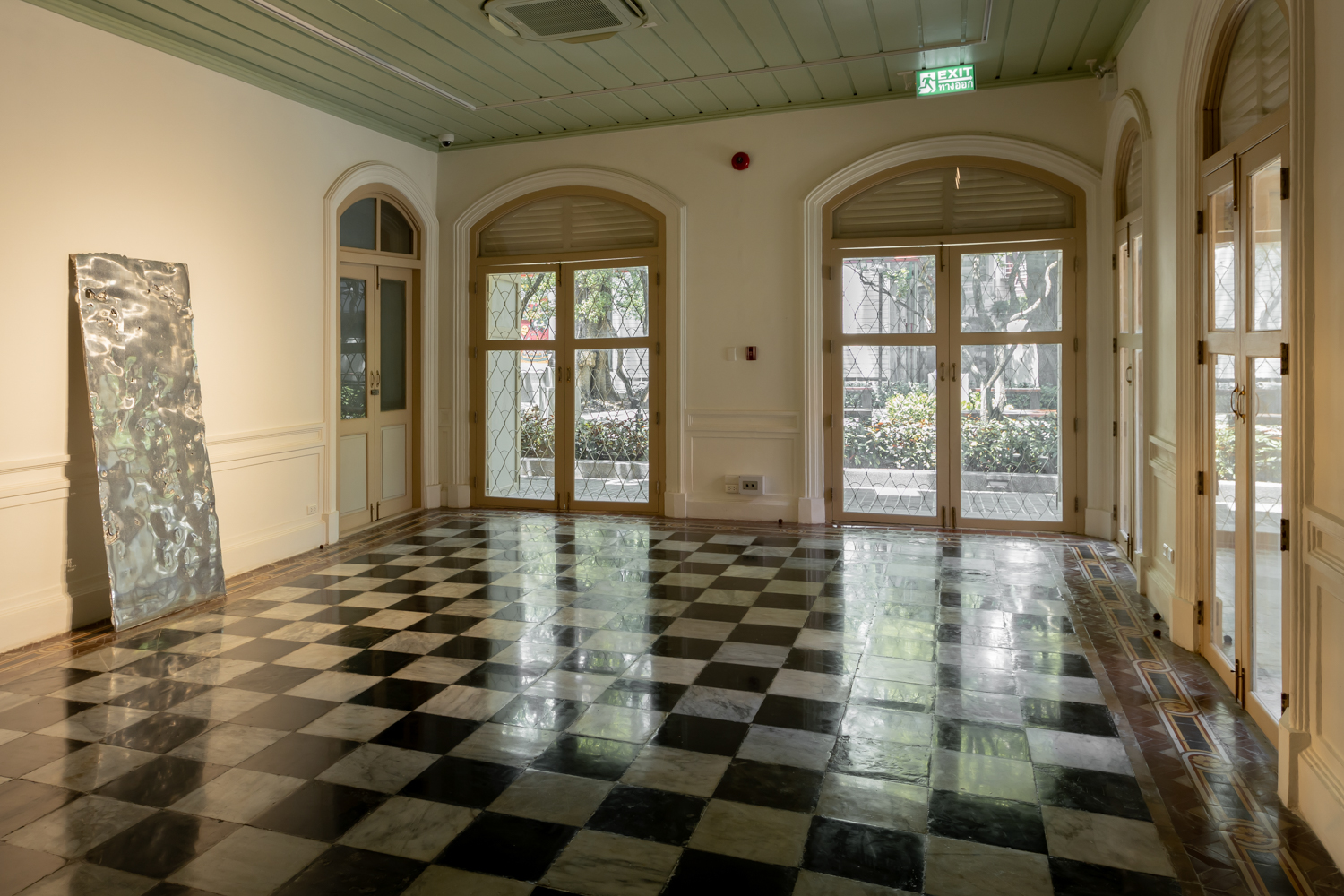

The work ‘You are part of everything you are not, 2021’ is an interesting testament of the aforementioned observation. Within the context of art exhibition, there is a visible connection between the two works, which is the transformation from one object to another- a bombshell to a mirror door, a wooden opium container turned into a Buddha sculpture. Taking a step back, one can see that the mirror does not only face toward the works displayed in the room and the reflected images reveal not just one Buddha sculpture but another one placed in Wang Luang building situated on the opposite side (the two Buddha sculptures also originate from the same country).
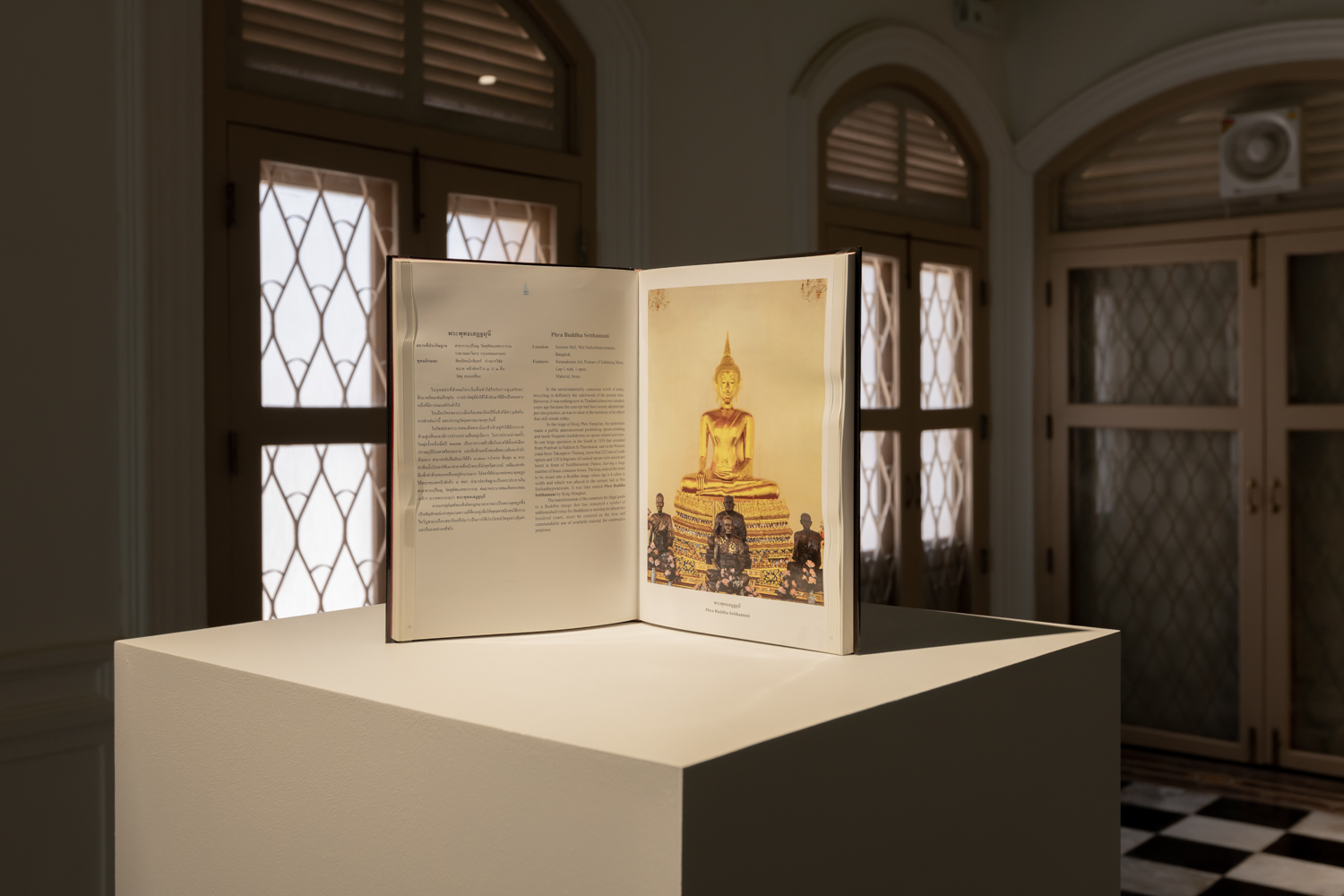
We are talking about the new doors emerging from the gradually revealing keywords. The non-hanging installation and the stage of ambiguity between the works waiting to be displayed or kept away indicate two things. Firstly, it’s an implication of the art gallery’s status whose past, present, and future serve as a space that will endlessly accommodate exhibitions after exhibitions. The history of the space will also be deviated by different stories (and the time in which each story takes place), making it historically distinctive when being compared to other types of buildings. Secondly, it enables us to notice the formats in which the works are installed (on the floor and on the display stands). Dr. Sayan Daengklom, a Lecturer from the Art History Department of the Faculty of Archaeology, Silpakorn University, made an observation that philosophy has an interesting way of positioning art. The use of display stands isn’t really surprising considering how Buddhist monks usually place religious books on a book stand. But it is the stand that turns a Buddhist book into an artwork and ends up changing the essence of the book itself. A small tool that keeps the book open in a specific page eliminates the book’s original functional purpose from something we read to an object we look at. And for the viewers, the photographs of Phra Buddha Setthamunee become an actual sculpture within the context of the exhibition.
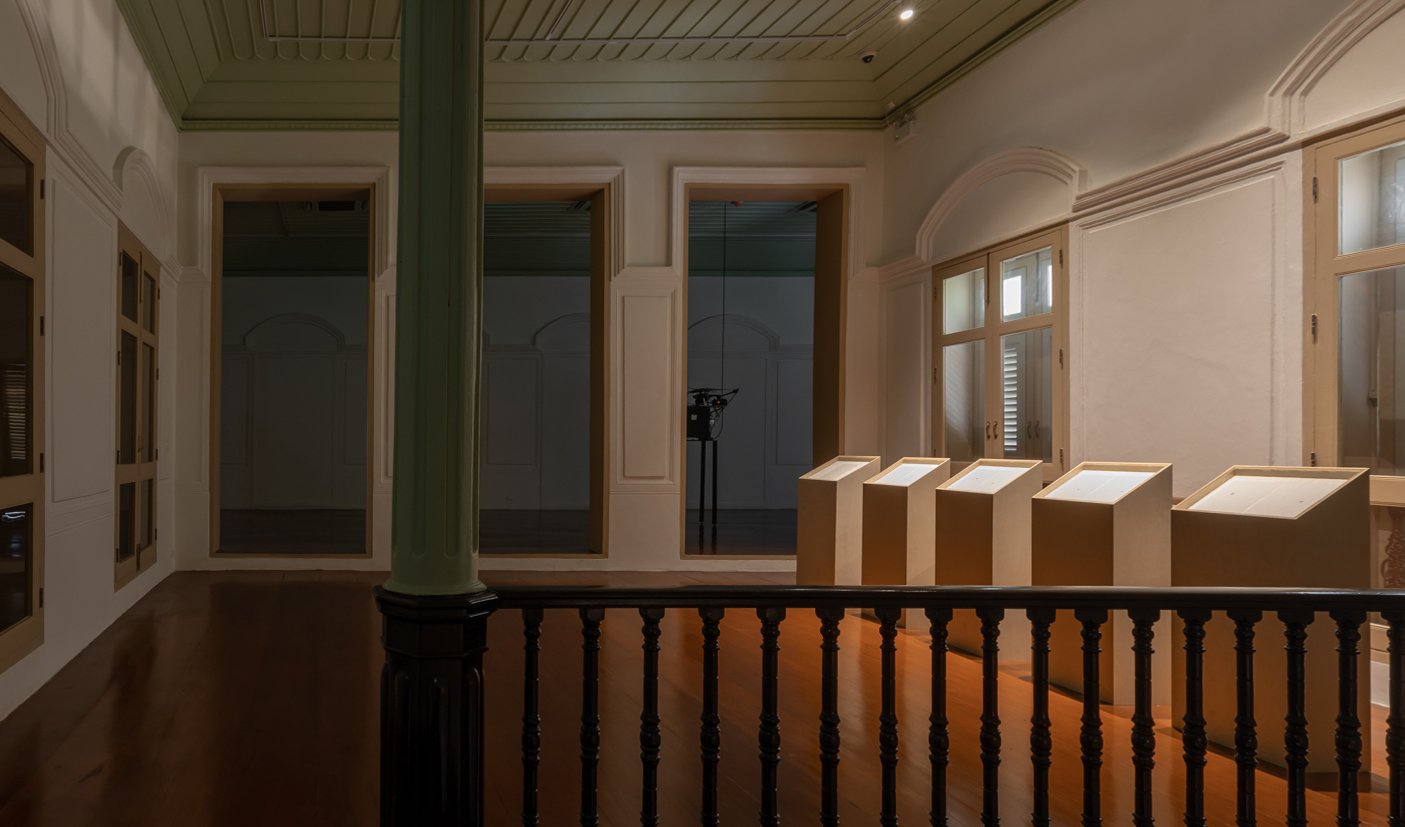
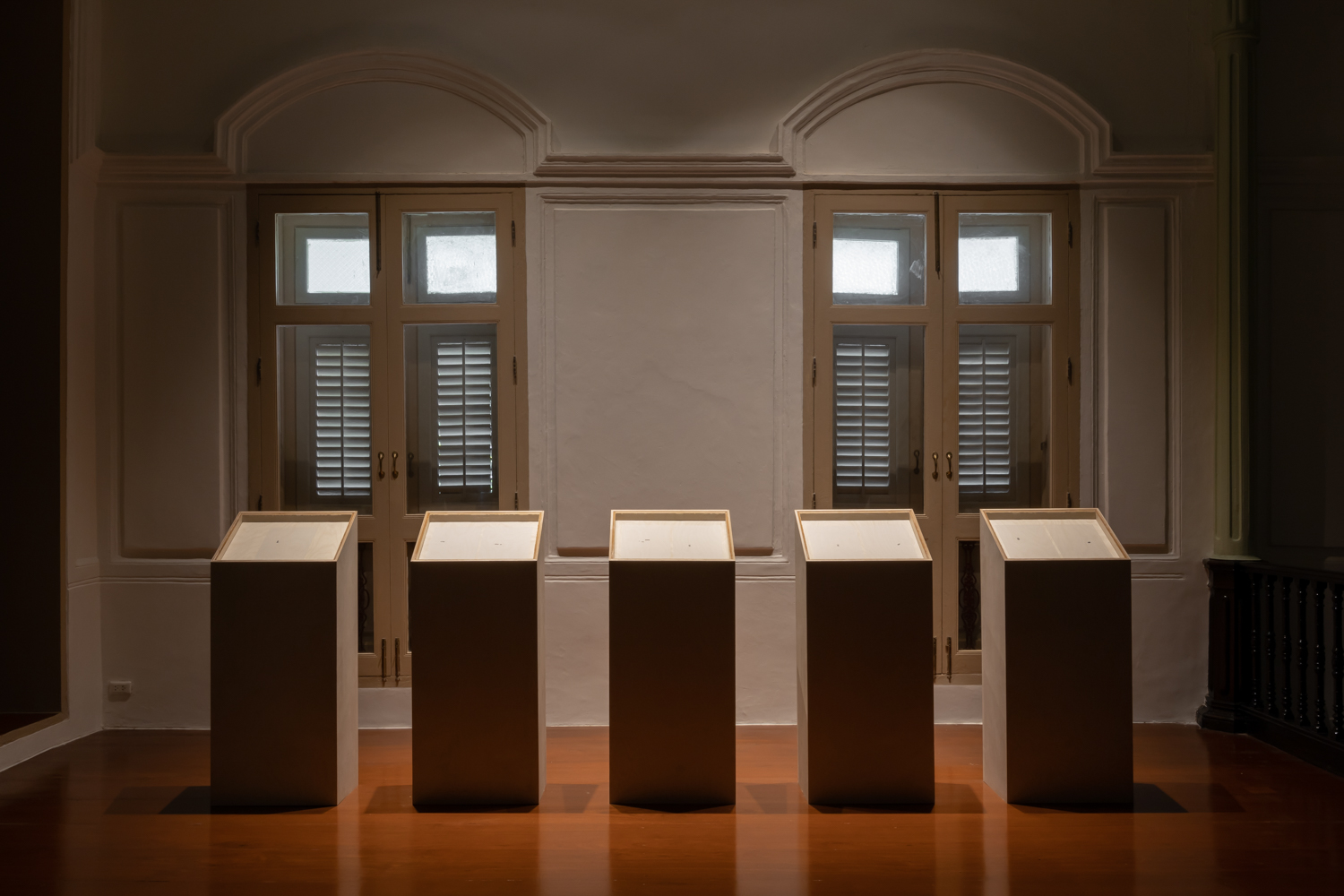
The floor is another worthwhile feature to mention. Pratchaya designs the viewing experiences where viewers are asked to take off their shoes and leave them outside before walking through the art space with their bare feet. Our feet get to feel the surface of the stone tiles on the ground floor and the polished teakwood on the second floor. When reaching Internal Rhyme, 2015, my eyes looked towards the drawing that seemed so out of place from other works featured in the exhibition. It’s the drawing of the front porch of Pridi Banomyong’s house in France. With this work, the artist drew with an internal rhyme that connects the human senses at the tip of his tongue to the tip of the pencil, physically and internally interacting with the model, which is the floor of the front porch of the house Pridi lived during days in France.” This message is included in the exhibition pamphlet and further explained by Kritsada that Pridi’s departure to France, which marked the end of the fight between the old and new powers, rendering a silent ending. Internal Rhyme brings fore and talks about how a side of the history is being learned with the senses and perceptions one may find unfamiliar.
Pratchaya’s decision to bring back the work he created in 2015 may have its reason to which we do not know. Nevertheless, it brings Pridi Banomyong’s name back to this art gallery. Watching the Extended Release video one more time, I discovered that the installation was put together back in the days when the art gallery was still in the middle of construction chaos. The camera panned to different parts of the room, capturing the canvases leaning against different sections of the walls of the exhibition space. Perhaps the video is the behind the scene footage of the 31 works after all? Extended Release depicts the time when the Art Center building was shaken by construction tools, vibrated when being stumped on by footsteps of construction workers whose faces we do not know and who have never been credited as the builders in Thailand’s art history. One can say that Pratchaya turns that temporary, fragile moment of the art gallery into a work of art itself.
Extended Release by Pratchaya Phinthong is being held from March 19th – May 15th and June 22nd – July 17th, 2021

